PF3D7_1116400 guanine nucleotide-exchange factor SEC12 (SEC12)
Disruptability [+]
| Species | Disruptability | Reference | Submitter | |
|---|---|---|---|---|
| P. falciparum 3D7 |
Refractory |
USF piggyBac screen (Insert. mut.) | USF PiggyBac Screen | |
| P. berghei ANKA |
Refractory |
PlasmoGEM (Barseq) | PlasmoGEM | |
Mutant phenotypes [+]
None reported yet. Please press the '+' button above to add one.Imaging data (from Malaria Metabolic Pathways)
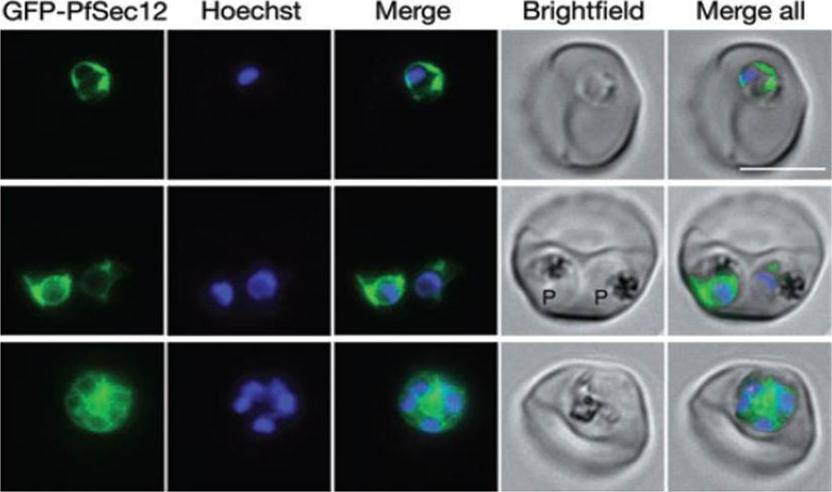
Live cell imaging of parasites expressing GFP–PfSec12 from the endogenous pfsec12 5′ UTR. Nuclei were stained with Hoechst 33342. GFP–PfSec12 is distributed in a perinuclear pattern with additional reticular protrusions characteristic of the parasite ER. Parasites at the ring, trophozoite and schizont stages are shown in the top, middle and bottom rows respectively. Note that the trophozoites (labelled P) were in a doubly infected erythrocyte. Bar = 5 mm.Lee MC, Moura PA, Miller EA, Fidock DA. Plasmodium falciparum Sec24 marks transitional ER that exports a model cargo via a diacidic motif. Mol Microbiol. 2008 68:1535-46.
See original on MMP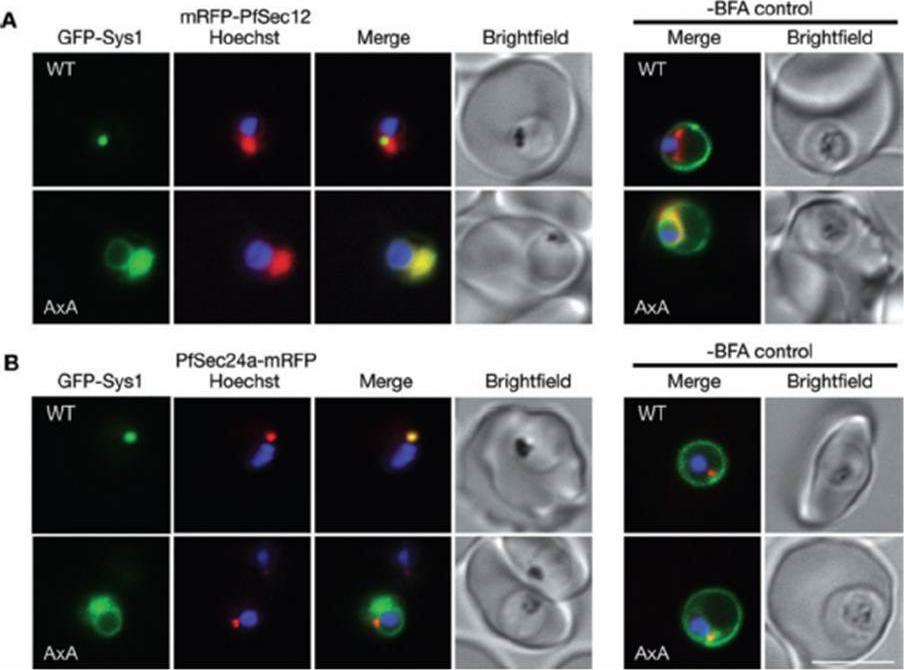
Brefeldin A (BFA) treatment causes retention of GFP-Sys1 at tER sites in an export signal dependent manner. Parasites coexpressing either GFP-Sys1DxE (WT) or GFP-Sys1AxA (AxA) with (A) mRFP-PfSec12 (from the calmodulin 5′ UTR) or (B) PfSec24a-mRFP were treated with 5 μg ml-1 BFA for 16 h prior to imaging. A merged image of a mock-treated control is shown for comparison. ER-retained GFP-Sys1AxA colocalized with PfSec12 throughout the ER (A), whereas GFP-Sys1DxE was enriched at tER sites coincident with PfSec24a (B). Bar = 5 μm.Lee MC, Moura PA, Miller EA, Fidock DA. Plasmodium falciparum Sec24 marks transitional ER that exports a model cargo via a diacidic motif. Mol Microbiol. 2008 68(6):1535-46. PMID:
See original on MMP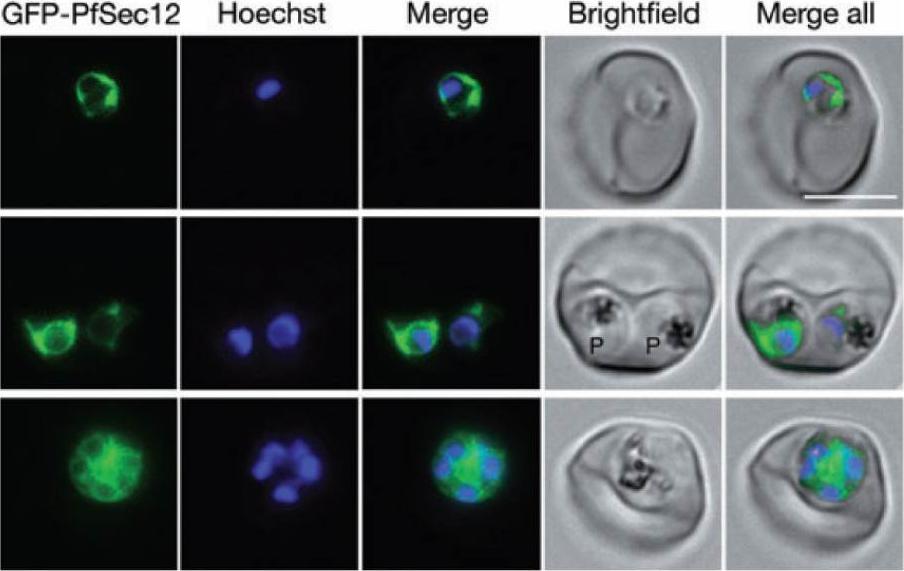
Characterization of PfSec12. Live cell imaging of parasites expressing GFP-PfSec12 from the endogenous pfsec12 5′ UTR. Nuclei were stained with Hoechst 33342. GFP-PfSec12 is distributed in a perinuclear pattern with additional reticular protrusions characteristic of the parasite ER. Parasites at the ring, trophozoite and schizont stages are shown in the top, middle and bottom rows respectively. Note that the trophozoites (labelled P) were in a doubly infected erythrocyte. Bar = 5 μm.Lee MC, Moura PA, Miller EA, Fidock DA. Plasmodium falciparum Sec24 marks transitional ER that exports a model cargo via a diacidic motif. Mol Microbiol. 2008 68(6):1535-46. PMID:
See original on MMP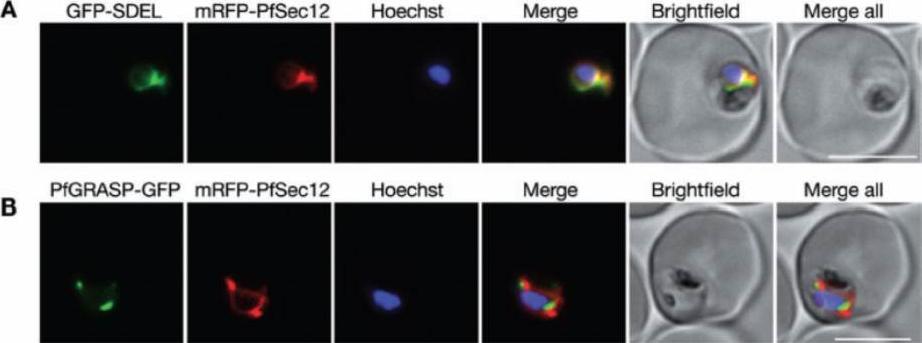
Comparison of PfSec12 localization with markers for the ER and Golgi. Parasites were cotransfected with plasmids for expression of mRFP-PfSec12 (from the native pfsec12 5′ UTR) with either (A) GFP-SDEL, a marker for the general ER, or (B) PfGRASP-GFP, a cis-Golgi marker. mRFP-PfSec12 was localized throughout the ER coincident with GFP-SDEL, in close apposition to PfGRASP-labelled Golgi. Bar = 5 μm.Lee MC, Moura PA, Miller EA, Fidock DA. Plasmodium falciparum Sec24 marks transitional ER that exports a model cargo via a diacidic motif. Mol Microbiol. 2008 68(6):1535-46.
See original on MMP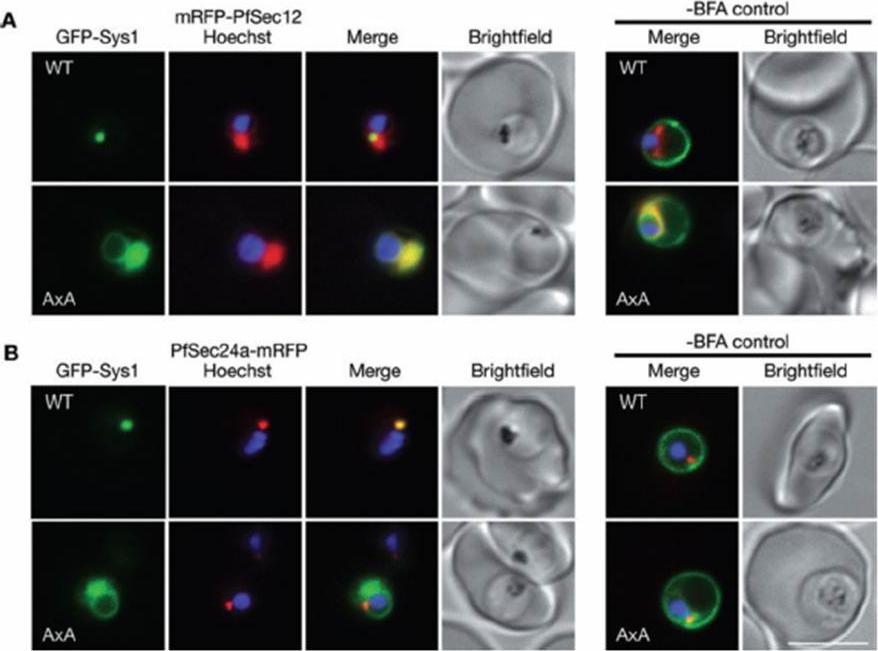
Brefeldin A (BFA) treatment causes retention of GFP-Sys1 at tER sites in an export signal dependent manner. Parasites coexpressing either GFP-Sys1DxE (WT) or GFP-Sys1AxA (AxA) with (A) mRFP-PfSec12 (from the calmodulin 5′ UTR) or (B) PfSec24a-mRFP were treated with 5 μg ml-1 BFA for 16 h prior to imaging. A merged image of a mock-treated control is shown for comparison. ER-retained GFP-Sys1AxA colocalized with PfSec12 throughout the ER (A), whereas GFP-Sys1DxE was enriched at tER sites coincident with PfSec24a (B). Bar = 5 μm.Lee MC, Moura PA, Miller EA, Fidock DA. Plasmodium falciparum Sec24 marks transitional ER that exports a model cargo via a diacidic motif. Mol Microbiol. 2008 68(6):1535-46.
See original on MMPMore information
| PlasmoDB | PF3D7_1116400 |
| GeneDB | PF3D7_1116400 |
| Malaria Metabolic Pathways | Localisation images Pathways mapped to |
| Previous ID(s) | PF11_0171 |
| Orthologs | PBANKA_0931600 , PCHAS_0912700 , PKNH_0914100 , PVP01_0917000 , PVX_091450 , PY17X_0933600 |
| Google Scholar | Search for all mentions of this gene |